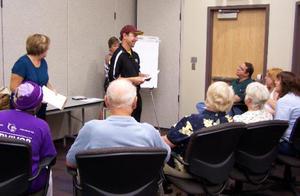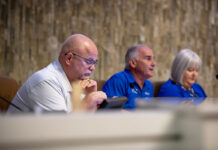
The city of Maricopa’s Town Hall Saturday afternoon offered residents the opportunity to ask questions, express concerns and be part of focus groups offering feedback regarding community recreational facilities.
Held at the MUSD district office building, the session began with the introductions of various city staffers, as well as vice-mayor Edward Farrell and new city councilman Alan Marchione.
Mayor Anthony Smith welcomed several special interest groups, including Grace Gomez, representing the Optimist Club and the Relay for Life cancer walk, several members of the ‘Copa Seniors and their president Carol Grandfield, who are looking for a meeting site for their group, MUSD volunteer coordinator Margaret Jackson, who presented a ‘Raise a Reader’ community reading plan, Therese Starkey of Maricopa Seniors, offering Pendants for Life, Cecilia Ashe of Maricopa Rotary Club, Friends of the Library members and LeeAnne Clark, a F.O.R. food bank volunteer.
One of the approximately 50 residents in attendance raised this question: ‘Is there anything citywide to control flies?’ “The agricultural sources and feedlots are leaving; three-fourths of the cattle will be gone in a short period of time,” said Smith. Although the county offers mosquito spraying, Smith said he was not aware of anything to control flies. “The flies are still here,” he said.
Another question addressed litter from trucks carrying garbage along state Route 287 to the Mobile landfill. Transportation director Brent Billingsley indicated that Auto Trucking and Waste Management acknowledge the problem and are “very responsive.” The company has done three trash pick-ups in the last year with a fourth one recently. “I think they’re doing a pretty good job,” Billingsley said.
City manager Kevin Evans added, “If you see a truck not covered or losing a load, get the plate number and report it.” All such trucks, by law, must have covered loads.
Helen Brown inquired about usage of the vacant church building on Honeycutt Avenue, which the city purchased in the fall. “The limiting factor is parking,” said assistant city manager Roger Kolman, explaining that there will be 20 parking spaces in the back, but the city is posting no parking signs on the north side of Honeycutt at the corner of state Route 347 due to the danger of pedestrians crossing a busy street. The church building itself was purchased prior to and in consideration of a future Honeycutt Avenue widening project.
Kolman also addressed a question regarding the regional park setting located eight miles west of the Palo Verde Mountains, which was included in the 2008 open space master plan. The park is “on the radar,” he said, adding that so were other BLM land areas.
In 2000 Maricopa had about 1,040 residents; this year’s census is expected to indicate 40,000 Maricopans. “The population has grown phenomenally; unfortunately, the facilities to serve that population have not,” Kolman said. He explained that Rotary Park and its pool have served the community for 50 some years and HOA pocket facilities are not designed for general population use. Pacana Park, which opened in 2006 with a 2009 final 10-acre completion, was meant to accommodate 15,000 residents.
In 2008 the citizenry approved a $65.5 million bond for community amenities in the following incremental bond issuances:
$20 million for a regional park
$16.6 million for an aquatic center/ multigenerational center
$15.5 million for a main library facility
$13.4 million for another, future regional park in the Eagle Shadows area
By the end of this month the city should close on its purchase of 140 acres south of the Union Pacific Railway tracks at Bowlin Road and state Route 347. That parcel, according to Kolman, has room “to build any or all facilities.”
With that project history in mind, attendees joined one of five focus groups to respond to the following questions:
· Which of the five projects (two regional parks, an aquatics center, a multigenerational center or a main library) is the most pressing need for our community? Why?
· For a regional park, what amenities would you like to see included?
· Would the community prefer a joint multigenerational center or two separate centers, one for youth and one for seniors? Why?
· When considering the aquatic center project, would you like to see an indoor and outdoor facility, all indoor or all outdoor? Why?
Each focus group presented its responses to these questions, providing resident feedback on community recreational facilities for the future use and consideration of the city and its staff.
Photo by Joyce Hollis








![Rizz party organizers say city ‘lying’ One of several flyers for a "TikTok rizz party" is taped to a door in the Maricopa Business Center along Honeycutt Road on April 23, 2024. [Monica D. Spencer]](https://www.inmaricopa.com/wp-content/uploads/2024/04/spencer-042324-tiktok-rizz-party-flyer-web-218x150.jpg)


![Maricopa restaurateur makes Food Network connection [Namkeen Dhaba]](https://www.inmaricopa.com/wp-content/uploads/2024/04/439456716_377105198650519_7536248579664805896_n-218x150.jpg)
![Merging lanes incite more 347 anger A merging lane sign sits on the side of State Route 347 northbound lanes during evening traffic on April 30, 2024. [Monica D. Spencer]](https://www.inmaricopa.com/wp-content/uploads/2024/04/spencer-043024-adot-merging-lanes-347-web-218x150.jpg)




